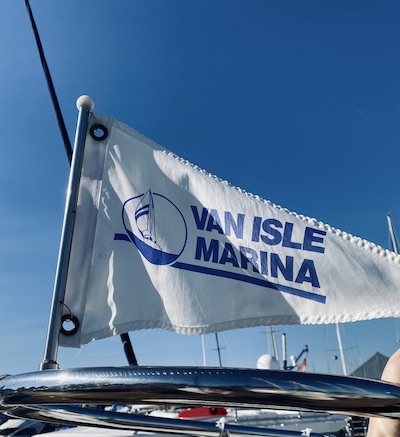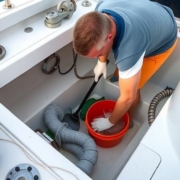A Comprehensive Guide to Boating Flags and Their Uses
Boat Flags Meaning and Proper Use
While walking the marina docks, you may have noticed that the yachts and boats moored there display several boating flags.
These little pieces of cloth are actually an important communication tool for boaters and port authorities alike, as they are a quick and simple way to convey a message.
In this blog, we will explore boat flag meanings for the most commonly seen and used boat flags.
The History of Boating Flags
Simply put, the term “boating flags” is an umbrella term that refers to a system of flags designed to act as quick communication devices for boat or ship operators.
Nautical flags were originally used in naval battles as a way for one ship to communicate with other fleet members. Since these early flag-based communications were limited, they essentially acted as a way of letting other fleet members know that a meeting was needed to discuss tactics or relay further instruction.
In the 1700s, more elaborate flag signals were developed, which resulted in the creation of the Royal Navy’s Permanent Fighting Instructions, which detailed 45 possible messages using only 11 flags.
In 1738, a French officer by the name of Mahé de la Bourdonniase developed the first numerical flags. Bourdonnaise’s new system made possible a whopping 1,000 potential messages using only 3 flags.
The system of boating flags has since evolved to contain 26 square flags (for the letters of the alphabet), 10 numbered pennant flags, 1 answering flag and 3 substitute flags. These are collectively known as the International Code of Signals.
Beyond these flags, yacht clubs and other marine organizations may have their own flags, for use by their members. There are also fishing flags, which are used by vessels to indicate what type of fish they are catching.
What You Need to Know About Boating Flags
There are a few things that boat operators need to know about boating flags before using them.
- Boating flags only come in blue, yellow, white, black and red because these colours are easy to recognize.
- Flags are sometimes flown at half-mast out of respect for someone who has died.
- Flags vary in size according to the size of the boat you have. This is done for aesthetic reasons, with flags being roughly 1” in length for every foot of boat length.
- Flying the wrong flag in a given situation may result in a fine.
- Signal flags can cost from $12 for one and up to $175 for a complete set.
- Shapes are important. Most boating flags are square, but there are also pennants (triangular, but flat at the tip) and triangles.
- Whether used individually or in combination, all boating flags mean something.
- Signals can be broken down by the number of flags in them. For example, single-flag signals mean urgent, while 5 flags have to do with position and time.
- Some flags can have more than one meaning, depending on the context. For example, the ‘T’ flag can mean ‘keep clear’ or ‘engaged in trawling’.
- Keep your flags in good condition. Flying tatty-looking flags can be considered disrespectful and may result in a fine. This is because flags that are in poor condition may not be clear or bright enough to be seen from a distance.
Types of Boating Flags and Their Meanings
The flags in the international code of signals each has a unique design and colour pattern that is easy to see and understand. The code is made up of the following flags:
- 26 signal flags – each flag represents a letter of the alphabet with a phonetic word to match (i.e., the letter A, or Alpha, is a blue and white flag)
- 10 numerical pennant flags
- 3 alternate flags
- 1 code/answer flag
Although there are too many signal flags and pennants to list here, as a boater, it’s a good idea to get to know how they look and what they are used for.
Aside from these boating flags, there are a few others to be aware of. These include:
- Boating distress signal flag. Two flag formations can be used to signify distress. The first is to display the N flag over the C flag, the other is an orange flag featuring a black circle and square. Ensure you are aware of the recognized standard marine distress signals for the area you are boating in.
- Ensign flags. This is a flag of the nation the boater comes from, which is not the national flag. These flags used to be for documented vessels only, but now it is a courtesy for all boats to fly them.
- Burgee flags. This is a small flag that represents whatever sailing organization or yacht club the skipper belongs to.
- Private signal flags. These flags are small and are custom designed and made for the boat owner. They are only flown when the owner is commanding the boat.
- Courtesy flags. Courtesy flags are flown when you are in foreign waters, but only after certain criteria are met.
Boating Flag Courtesies
When using or displaying boating flags, there are some basic courtesies to be aware of:
Here are some basic boating flag courtesies to keep in mind:
- When in your own country’s waters, fly the correct ensign flag for your country at the stern of your boat.
- When you are in foreign waters, fly the “Q” flag before you gain clearance to enter the port. The “Q” flag should be flown from the starboard spreader on sailboats, or the bow on powerboats.
- After clearing customs in a foreign country, switch the “Q” flag to the one that belongs to the country you are visiting.
- Upon returning to your own country, switch back to its ensign flag.
The Importance of Flying Your Boat Flags Correctly

Although boating flags may seem like a fun accessory for avid boaters, they are a serious communication tool.
It’s important that you know how to identify boating flags and their meanings and understand when they should be flown. Proper use of the flags will ensure that you receive the support you need and avoid confusing other boaters.
Want to get your own captain’s flag by becoming the proud owner of a brand new or used yacht? The yacht sales team at Van Isle Marina, located in Sidney, BC, can help you choose which of our current yacht listings is right for you. We’ll even provide a complementary burgee!
Contact the team at Van Isle Marina today to find out more.
